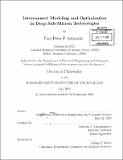Interconnect modeling and optimization in deep sub-micron technologies
Author(s)
Sotiriadis, Paul Peter P. (Paul Peter Peter-Paul), 1973-
DownloadFull printable version (10.37Mb)
Other Contributors
Massachusetts Institute of Technology. Dept. of Electrical Engineering and Computer Science.
Advisor
Anantha P. Chandrakasan.
Terms of use
Metadata
Show full item recordAbstract
Interconnect will be a major bottleneck for deep sub-micron technologies in the years to come. This dissertation addresses the communication aspect from a power consumption and transmission speed perspective. A model for the energy consumption associated with data transmission through deep sub-micron technology buses is derived. The capacitive and inductive coupling between the bus lines as well as the distributed nature of the wires is taken into account. The model is used to estimate the power consumption of the bus as a function of the Transition Activity Matrix, a quantity generalizing the transition activity factors of the individual lines. An information theoretic framework has been developed to study the relation between speed (number of operations per time unit) and energy consumption per operation in the case of synchronous digital systems. The theory provides us with the fundamental minimum energy per input information bit that is required to process or communicate information at a certain rate. The minimum energy is a function of the information rate, and it is, in theory, asymptotically achievable using coding. This energy-information theory combined with the bus energy model result in the derivation of the fundamental performance limits of coding for low power in deep sub-micron buses. Although linear, block linear and differential coding schemes are favorable candidates for error correction, it is shown that they only increase power consumption in buses. Their resulting power consumption is related to structural properties of their generator matrices. In some cases the power is calculated exactly and in other cases bounds are derived. (cont.) Both provide intuition about how to re-structure a given linear (block linear, etc.) code so that the energy is minimized within the set of all equivalent codes. A large class of nonlinear coding schemes is examined that leads to significant power reduction. This class contains all encoding schemes that have the form of connected Finite State Machines. The deep sub-micron bus energy model is used to evaluate their power reduction properties. Mathematical analysis of this class of coding schemes has led to the derivation of two coding optimization algorithms. Both algorithms derive efficient coding schemes taking into account statistical properties of the data and the particular structure of the bus. This coding design approach is generally applicable to any discrete channel with transition costs. For power reduction, a charge recycling technique appropriate for deep sub-micron buses is developed. A detailed mathematical analysis provides the theoretical limits of power reduction. It is shown that for large buses power can be reduced by a factor of two. An efficient modular circuit implementation is presented that demonstrates the practicality of the technique and its significant net power reduction. Coding for speed on the bus is introduced. This novel idea is based on the fact that coupling between the lines in a deep sub-micron bus implies that different transitions require different amounts of time to complete. By allowing only "fast" transitions to take place, we can increase the clock frequency of the bus. The combinatorial capacity of such a constrained bus ...
Description
Thesis (Ph. D.)--Massachusetts Institute of Technology, Dept. of Electrical Engineering and Computer Science, 2002. Includes bibliographical references.
Date issued
2002Department
Massachusetts Institute of Technology. Department of Electrical Engineering and Computer SciencePublisher
Massachusetts Institute of Technology
Keywords
Electrical Engineering and Computer Science.